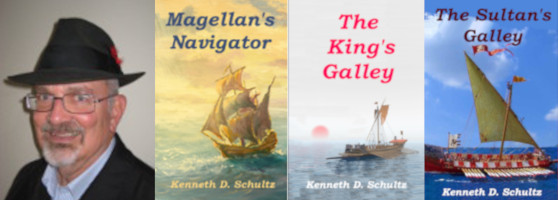 Scurvy took its deadly toll on every long voyage during the age of exploration. Twenty years before Magellan left Spain, Vasco da Gama lost over half his men to scurvy on his return voyage from India. In comparison, Magellan lost only eleven percent of his crew when sailing across the immense Pacific Ocean.
Scurvy took its deadly toll on every long voyage during the age of exploration. Twenty years before Magellan left Spain, Vasco da Gama lost over half his men to scurvy on his return voyage from India. In comparison, Magellan lost only eleven percent of his crew when sailing across the immense Pacific Ocean.
Many authors I have read claim quince preserves accounted for Magellan’s low losses to scurvy. Quince preserves were a medicinal item during the Renaissance, as opposed to a tasty accompaniment to hardtack. Magellan’s quince preserves or marmelada probably were not like grocery store cherry or blueberries preserves. Instead, it was more likely the aged quince marmelada still sold today in Portugal, which has a firm texture. (Please see the accompanying photograph of quince marmelada purchased by my wife last year in Portugal.) Quince in this form should have stood up well to the rigors of Magellan’s long voyage. We know Magellan still had his quince preserves after sailing across the Pacific and reaching the Philippines as he gave it to the sick brother of the Cebu rajah per Antonio Pigafetta in his book Magellan’s Voyage. That Magellan still had the preserves confirms that he considered it medicine, as the crew consumed anything remotely edible in the long voyage across the Pacific Ocean.
Quince preserves has only about a third the vitamin C as citrus fruit, but it still packs enough punch to ward off scurvy. The importance Magellan attributed to quince can be measured by the 5,779 maravedis he spent on it in Seville, as compared to the 23,037 maravedis he spent on hundreds of pounds of beans. Did quince account for the relative healthiness of Magellan’s crew?
It probably helped, but a deep dive into the data gives us a better answer.
Deaths for all reasons because of the Pacific transit were as follows*:
Trinidad 4 of 60-70 6%
Victoria 14 of 45-52 29%
Concepcion 1 of 44-52 2%
Total 19 of 174 11%.
These figures raise several questions. First, the bulk of the deaths are on the Victoria. Furthermore, these deaths started a month after leaving the strait, while scurvy usually takes three months to develop. The fleet took 94 days from raising anchor in the Straits of Magellan to landfall on Guam, where fresh food was procured. So, the fatalities on the Trinidad and Concepcion are as might be expected, but why was the Victoria so savaged by scurvy and why did in occur so soon?
The key can be found in Pigafetta’s book, where we learn the Victoria spent two weeks searching the Straits of Magellan for the San Antonio, which had defected back to Spain. Meanwhile, the other two ships spent some of that time anchored in the “Bay of Sardines.” There Pigafetta says, “…we found…a very sweet herb called appio, of which there is also some of the same sort that is bitter. And this herb grows near springs, and (because we had nothing else) we ate of it for several days.” Appio is believed to be a wild celery rich in vitamin C.
Mystery solved. Those aboard the Trinidad and Concepcion had ample vitamin C stored in their bodies on leaving the strait, except for a few finicky eaters, like the Englishman Andrew of Bristol, who died soon after leaving Guam. The last fresh food eaten by the crewmen of the Victoria, on the other hand, was over a month earlier before Magellan even entered the strait. By landfall at Guam, 132 days at sea had elapsed for these men, and so the terrible death toll on the Victoria.
Perhaps the quince preserves had a role in preventing scurvy, but it was not the deciding factor during the crossing of the Pacific. In my novel Magellan’s Navigator, I built in a role for quince on the return voyage to Spain. My protagonist Albo remains scurvy free until he exhausts his last supply of quince marmelada. Soon afterward, his teeth start to loosen.
*The exact crew size of each ship is uncertain because around twenty-two of the crew of the wrecked Santiago transferred to these three ships. Some deaths occurred weeks after arriving in the Philippines, but are documented as being from effects of the Pacific transit
